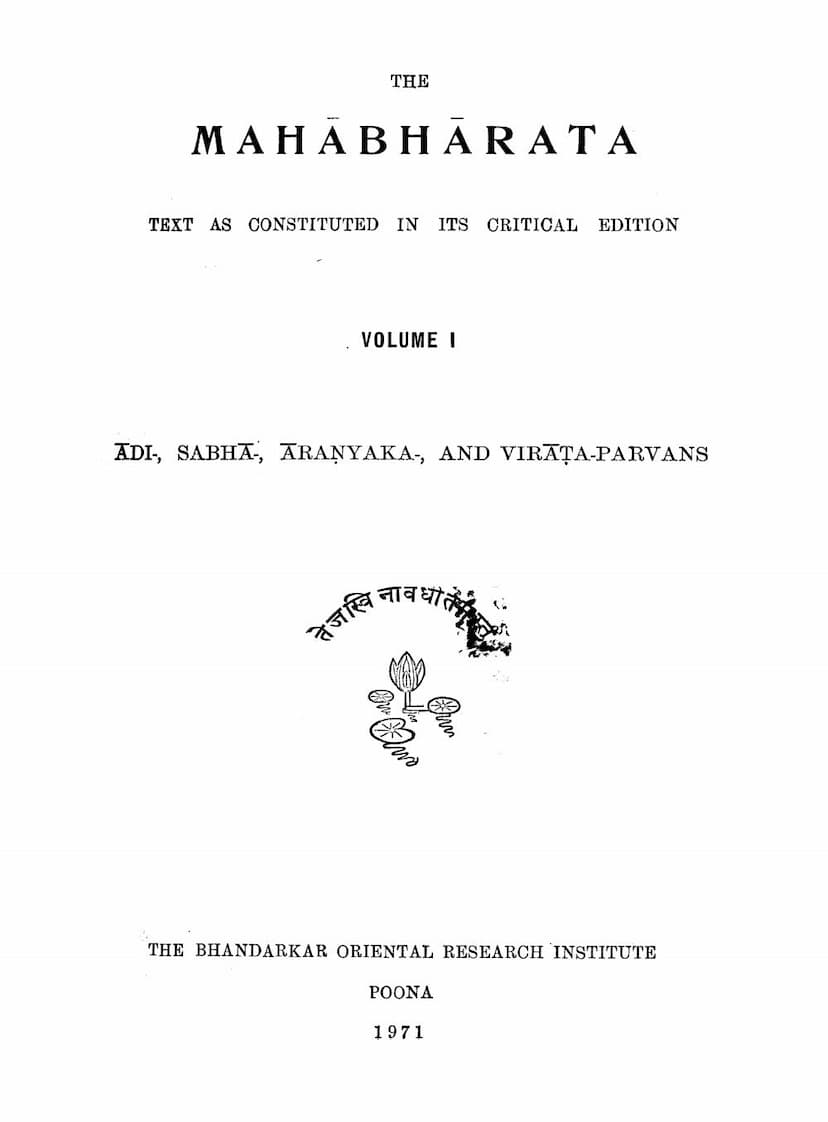Mahabharat Samhita Part 01
Added to library: September 2, 2025

Summary
Here's a comprehensive summary of the provided Jain text, "Mahabharat Samhita Part 01," authored by the Bhandarkar Oriental Research Institute, based on the provided catalog link and text snippets.
Overall Scope:
This volume, Mahabharat Samhita Part 01, published by the Bhandarkar Oriental Research Institute (BORI) in Poona in 1971, represents the initial installment of a project to make available the text of the Great Epic as constituted in its critical edition. Specifically, this volume covers the Adi Parvan, Sabha Parvan, Aranyaka Parvan, and Virata Parvan.
Key Objectives and Methodology:
- Public Access to Critically Edited Text: The primary goal was to provide the critically edited text of the Mahabharata to the general public, distinct from the more specialized scholarly apparatus (prolegomena, introductions, critical notes, etc.) included in the full Critical Edition.
- Reconstruction of Ancient Text: The constituted text presented in this volume is not claimed to be an original, "Un-Mahabharata" text, which is considered an ideal but impossible desideratum. Instead, it aims to represent the most ancient text of the Mahabharata that can be reconstructed based on all available manuscript and allied evidence.
- Cleansing and Preservation: The constituted text is described as being cleansed of later accretions and errors of copying. Simultaneously, it aims to rescue authentic archaisms that may have been gradually lost during transmission.
- Methodology: The specific methodology employed in the textual criticism of the Mahabharata is detailed in the Prolegomena of the Adiparvan and the introductions to the other Parvans within the full Critical Edition.
Content Covered in Part 01:
This volume is meticulously organized, presenting the epic section by section. The provided text includes an Anukramanika (Index) that lists the Parvans and their corresponding chapters and page ranges:
- Adi Parvan: Covers chapters 1-225 and spans pages 1-290. It includes numerous sub-Parvans (sections) detailing various narratives and genealogies, such as the Anukramanipatra, Parva Sangraha Parvan, Paushya Parvan, Pailloma Parvan, Astika Parvan, Adiwansha Avataran Parvan, Sambhava Parvan (with sub-narratives like Shakuntaloopakhyanam, Yayatyupakhyanam, Uttarayayatam), Jatugriha Dah Parvan, Hidimba Badha Parvan, Bakavadha Parvan, Chaitraratha Parvan (with Tapati, Vasishtha, Aurva Upakhyanas), Draupadi Swayamvara Parvan, Vaivahika Parvan, Vidura Agama Parvan, Rajyalambha Parvan, Arjuna Vanavasa Parvan (with Sundopasunda Upakhyanam), Subhadra Harana Parvan, Harana Harika Parvan, Khandava Dah Parvan (with Shangaka Upakhyanam).
- Sabha Parvan: Covers chapters 1-72 and spans pages 291-385. It includes sections like Sabha Parvan, Mantra Parvan, Jarashandha Badha Parvan, Digvijaya Parvan, Rajasuy Parvan, Ardha Amiharana Parvan, Shishupala Badha Parvan, Dyuta Parvan, and Anudhyuta Parvan.
- Aranyaka Parvan: Covers chapters 1-299 and spans pages 386-800. This is a substantial section, detailing the Pandavas' exile and including numerous narratives and philosophical discussions. Key sections mentioned are Aranyaka Parvan, Kairava Vadha Parvan, Karaita Parvan (with Saubha Vadha Upakhyanam), Indraloka Abhigamana Parvan (with Nala Upakhyanam), Tirtha Yatra Parvan (with Agastya, Rishyasringa, Kartavirya, Sukanya, Mandhata, Jantu Upakhyanas, Shyena Kotiyyam, Ashtavakra Yam, Yavakrita Upakhyanas, Sougandhika Haranam), Jatasura Vadha Parvan, Yaksha Yuddha Parvan, Ajagara Parvan, Markandeya Samasya Parvan (with Matsya, Manduka, Indradyumna, Dhumdhumar, Pativrata Upakhyanas, Brahmana Vyadha Samvada, Angirasa), Draupadi Satyabhama Samvada Parvan, Ghoshayatra Parvan, Mriga Svapna Bhaya Parvan, Vrihi Drona Parvan, and Draupadi Harana Parvan (with Ramayanam and Savitri Upakhyanas), Kundalaharana Parvan, Maraneya Parvan (with Yaksha Prasna).
- Virata Parvan: Covers chapters 1-67 and spans pages 801-875. It includes Vairata Parvan, Kichaka Vadha Parvan, Go Grahan Parvan, and Vaivahika Parvan.
Foreword and Acknowledgments:
The foreword, penned by R. N. Dandekar on July 6, 1971, highlights the persistent demand from the public for the critically constituted text. It also mentions ancillary works undertaken by the Mahabharata department after the completion of the Critical Edition in 1966, including a critical edition of the Harivamsa, a comprehensive index of verse quarters, and an epilogue to the Critical Edition. The volume is printed by R. N. Dandekar at the Bhandarkar Institute Press, Poona.
Key Philosophical/Textual Points:
- The foreword emphasizes that the constituted text is not absolute but represents the "most ancient text" reconstructible from evidence.
- It acknowledges the concept of diverse transmission and authorship, as poets, past, present, and future, recount this history.
- The introduction of the Adi Parvan begins with traditional invocations to Narayana, Nara, Devi Saraswati, and the uttering of "Jaya" (victory), followed by the narrative of the sage Lomaharshana's son, Ugrasrava, recounting the epic at the Naimisha forest sacrifice.
Overall Significance:
This volume is a foundational piece for scholars and readers interested in the Mahabharata's critically established text. It provides direct access to the epic's narrative structure and content, as reconstructed through rigorous textual scholarship, making the vast epic more accessible to a wider audience.